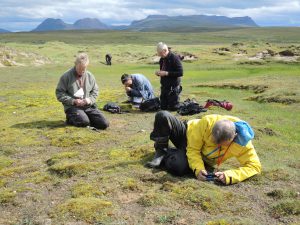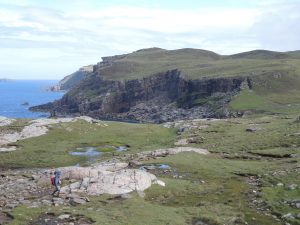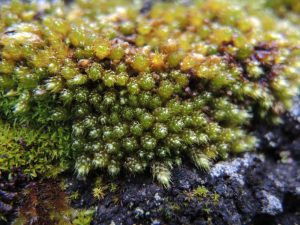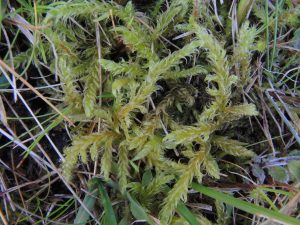Some of the most remote and beautiful wilderness landscapes in Scotland are in the extreme north-west, in Sutherland, so-called from the Vikings who regarded it as the south of their territory, and their influence lives on here in many of the Norse place names. What is less well-known is the remarkably rich flora of bryophytes, not only in the wild mountains like Arkle and Foinaven, but on the coast where some remarkable juxtapositions of floristic elements can be found.
The Nordic Bryological Society last met in Scotland in 1978 at Ardtornish Castle in Morvern, and another visit was deemed overdue, so Gordon Rothero and David Long were called in to make arrangements for a week in August 2015, based at the excellent hostel set in the spectacular limestone scenery of Inchnadamph.
Our group of 18 bryologists, from 6 different countries, sampled a rich diversity of habitats, such as the dramatic mountain corries of Quinag, the limestone valleys at Inchnadamph, the wooded midge-infested ravines near Drumbeg, and the wonderful sand dunes of Achnahaird Bay in Wester Ross. Every day produced a rich diversity of mosses and liverworts, many unfamiliar to Nordic eyes, but undoubtedly one of the most memorable days was that spent on the rugged coast at Sheigra, just south of the celebrated Sandwood Bay and only a few miles south of Cape Wrath.
Our goal on a rocky wind-blasted headland near Sheigra was a long-known site for the rare Hare-tail Moss, Myurium hochstetteri, a large and colourful oceanic moss which seems quite out of place in Scotland. Its genus Myurium, with about 14 species worldwide, is predominantly tropical, with only a single species M. hochstetteri found in north temperate regions from Macaronesia as far north as the Outer Hebrides where it is conspicuous and sometimes abundant on coastal rocks and heaths. However, there are only a handful of sites on the Scottish mainland, Sheigra being the farthest north known locality for both the genus and species.
However, having re-located and admired the Myurium,
what we did not expect to find, only a few feet away, was a previously unknown colony of another rarity, the St Kilda Hook-moss, Sanionia orthothecioides. A number of Arctic mosses and liverworts occur in Scotland, in the snow-beds of the Cairngorms and other high mountains, but Sanionia is an exception as it is strictly coastal. It is widespread in Arctic regions such as Svalbard where it grows by the sea in association with bird cliffs. In Scotland the species was first collected on St Kilda by the late Derek Ratcliffe in 1959, later identified and reported by David Long in 1992; subsequent targeted searches by Sandy Payne and others have shown it to be widespread on the coasts of NE Scotland, Orkney and Shetland, with two sites only on the north-west mainland. This new discovery is the first time it has been found growing close to Myurium, making this one of the most remarkable juxtapositions of Tropical and Arctic bryophyte elements known worldwide.




